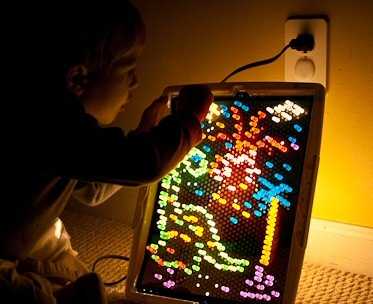The "trick" to having a mirror (beside turning off the self-illuminating parts of the CRT or LCD) is (1) high index of reflectivity (a number less than 100% for any two-material interface, but air and glass works fairly well) on a very flat surface (think glass or calm water) and (2) absorption or scattering of any unreflected light (think a heavily tinted car that you cannot peer into versus a non-tinted car window, or dark murky water vs shallow water where you can see the bottom). If you have a glossy screen iMac or iPhone (smooth glass) and you turn it off (black behind the glass) and the room has enough light or you are outdoors, the screen will be a mirror!
If you take a piece of glass and paint the back white, it will be pretty difficult to see reflections on it because (1) the white paint diffuses any transmitted light in many directions obscuring the reflected image in front and (2) glass/air isn't the most reflective surface (if it were highly reflective enough to make a mirror on its own we would never use it in automobiles). But if you paint a piece of glass black, it makes a decent mirror (in a well lit environment). (At my office we have one such black "whiteboard", the rest of the whiteboards are white (on the back) glass.)
Now take a piece of glass and vapor deposit aluminum on it (on the back so it won't scratch). (I did this in an Applied Physics class, not to make little mirrors, they were just a byproduct). Since aluminum is so reflective (see link) at visible light wavelengths, most of the light that enters the glass reflects off the back side when it hits the aluminum and returns to your eyes as a reflection. If you paint black behind the aluminum then you eliminate most stray diffuse/ambient light, which is more or less how standard household mirrors work.
So the "silver" paint is not just silver or light gray in "color" (a loaded word that's more complicated than we usually give credit for), the surface property is reflective (smooth like gold lamé) instead of diffuse (rough, like a yellow shirt---never to be mistaken for gold lamé no matter the color of yellow). Most of what we think of as every day "colors" (pigments) are diffuse.

9After you have explained him you should use a webcam to create a fake mirror... ;-) – Tamara Wijsman – 2010-09-03T19:37:06.730
2
A mirror needs more than the colour: http://en.wikipedia.org/wiki/Silvering
– Tamara Wijsman – 2010-09-03T19:39:39.097I told him about using a webcam but was still adamant you could make the screen silver. I also told him you just can't make the "colour" silver from light. He's bought Apple's "there's an app for that" too far as he thought someone could just make an app that rotated the pixels 180 degrees to show a silver surface :D It took a while for me to explain that wouldn't work anyway and that you can't just download hardware ;) – Jonathan. – 2010-09-03T21:01:28.890
webcams make inverted mirrors :) which are real pictures as mirrors invert reality. – laurent – 2010-09-04T03:22:13.037
Some webcam apps (Mac OS X Photo Booth) let the user switch from mirror to "actual" because most people are used to seeing their reflection rather than their actual appearance. – Jared Updike – 2010-09-04T06:53:07.747
I have made a iPhone app which uses the front camera and let's you tap the screen to flip from mirror to normal but I don't have an iPhone 4 to test it on, only a 3g – Jonathan. – 2010-09-04T07:17:35.203